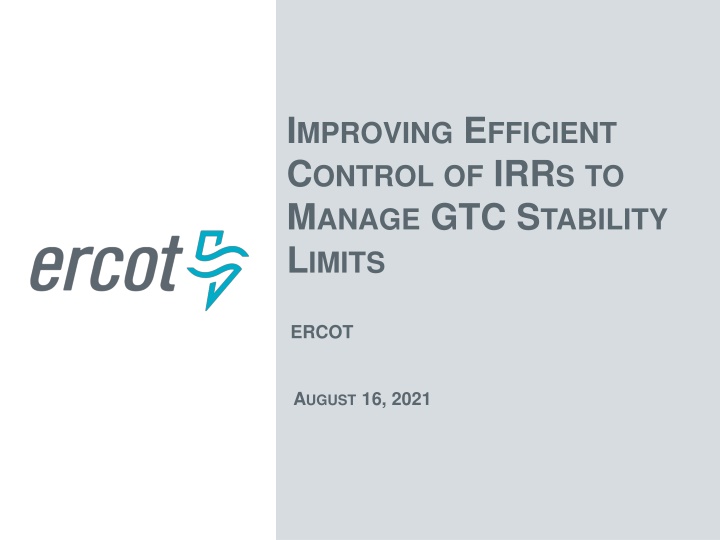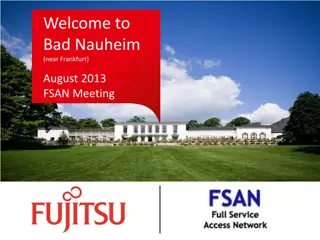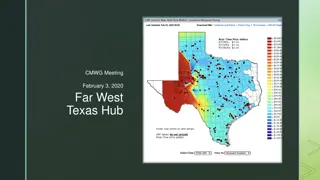
Efficient Control of Generic Transmission Constraints for GTC Stability in ERCOT
Explore the implementation of a proposed solution, the Not-To-Exceed Method, to efficiently manage GTC stability limits in ERCOT. Learn about the background of Generic Transmission Constraints (GTCs), the current methods of managing GTC flow, and the benefits of improving control over GTC limits. Stay informed about the management of GTC/IROLs and the process of managing GTC limits through SCED dispatches and factors like Shift Factor and Discount Factor.
Download Presentation

Please find below an Image/Link to download the presentation.
The content on the website is provided AS IS for your information and personal use only. It may not be sold, licensed, or shared on other websites without obtaining consent from the author. If you encounter any issues during the download, it is possible that the publisher has removed the file from their server.
You are allowed to download the files provided on this website for personal or commercial use, subject to the condition that they are used lawfully. All files are the property of their respective owners.
The content on the website is provided AS IS for your information and personal use only. It may not be sold, licensed, or shared on other websites without obtaining consent from the author.
E N D
Presentation Transcript
IMPROVING EFFICIENT CONTROL OF IRRS TO MANAGE GTC STABILITY LIMITS ERCOT AUGUST 16, 2021
Agenda Introduction Generic Transmission Constraint (GTC) Overview Current Method of Managing GTC Flow Proposed Solution: Not-To-Exceed Method Benefits Implementation Other Considerations Summary and Next Steps 2 PUBLIC
GTC Background Generic Transmission Constraints (GTCs): A transmission constraint made up of one or more grouped Transmission Elements that is used to constrain flow between geographic areas of ERCOT for the purpose of managing stability, voltage, and other constraints that cannot otherwise be modeled directly in ERCOT s powerflow and contingency analysis applications. Each GTC is designed so that the appropriate Resources are controlled (as a result of the GTC) to protect against the stability phenomenon Some GTCs have a closed interface (where all Resources behind the interface have a similar affect on the stability phenomenon) while others are an open interface (where different Resources have a different impact on the stability phenomenon From GTC limit management perspective, a margin is desirable to be maintained so as to accommodate unaccounted factors when determining GTC limit, which include, but not limited to deviations from base points For those GTCs designated as IROLs (Interconnection Reliability Operating Limits), a tighter control is needed to avoid IROL Exceedances in order to comply with NERC Requirement (New ERCOT SOL Methodology - IROL Assessment) Workshop on GTC was held on August 21st Slides: http://www.ercot.com/calendar/2020/8/21/209816 3 PUBLIC
Current GTC/IROLs (as of 8/16/21) A list of all GTC s can be found on the MIS posting: Generic Transmission Constraints Methodology GTC s and the posted documentation is considered ERCOT Critical Energy Infrastructure Information (ECEII) There are 16 GTC s 4 Interconnection Reliability Operating Limit s (IROL) 12 System Operating Limit s (SOL) *Transmission and Security Operating Procedure 4 PUBLIC
Management of GTC Limits SCED dispatches units in the most optimal manner in order not to exceed the GTC limit by considering offer and shift factor from Resources If all units have same SF (Shift Factor) on GTC elements (closed interface) then units with highest offers are curtailed down to where interface flow is within limit. It does this by setting SBBH (SCED Base Point Below HDL) flag for the marginal units and requiring them to not exceed (or follow) their UDBP (Updated Desired Base Point) Other infra-marginal units not required to follow UDBP since their SBBH flag is not set (those IRR units without SBBH flag to be set can increase output above UDBP, sometimes very quickly, if wind speed or irradiance allows them to do so). GTC Limit/ Discount Factor Shift Factor BP/UDBP [t, t+5] Generator Offer Curve SCED SBBH HSL/MW at time t **The effective GTC limit used by SCED is the GTC limit times discount factor 5 PUBLIC
Problem: Ramp-up for Un-curtailed IRRs Causes GTC Limit to be Exceeded Panhandle Limit Panhandle Interface Real Time Flow Panhandle Wind MW Panhandle Wind UDBP 2,800. 2,750. 2,700. 2,650. 2,600. MW 2,550. 2,500. 2,450. 2,400. 2,350. 2,300. Time Rapid changes in power production from IRRs without SBBH flag set may result in GTC exceedance. (Add discount factor during this period) 6 PUBLIC
Current Approach Current approach: to bind and dispatch GTC flow to a certain lower limit (percentage of actual limit) due to potential for IRR units that do not have SBBH flag to ramp up. This percentage is lower for GTCs that are IROLs due to increased reliability implications of exceeding the limit Selecting the appropriate percentage: Controlling to a higher percentage of the limit will not be sufficient to avoid exceedances in the case when IRRs ramp up (reliability risk) Controlling to a lower percentage of the limit may lead to excessive curtailment of IRRs (efficiency loss) and more binding intervals for all units behind the GTC If assessed as IROL, a lower percentage may be needed per Operating Procedure to avoid NERC reporting 7 PUBLIC
Panhandle GTC Limit Exceedance From January to September 2020, ERCOT controlled to 90-95% of the actual limit for the vast majority of intervals, there were a total of 136 instances of exceedance of Panhandle GTC limit between Jan. and Sep. 2020 Now that the Panhandle GTC is an IROL, ERCOT has controlled to 85-90% of the limit, in order to prevent any exceedances which in turn results in more binding intervals and curtailment 8 PUBLIC
Proposed Concept: Not-to-Exceed (NTE) Method General description IRR units behind a binding GTC with a considerable impact over the GTC flow (which units) should NOT exceed their SCED BP (how) when NTE is activated (when). NTE Method parameters: Triggering condition: To be determined. Trigger conditions being considered are: When GTC loading is above a threshold When GTC constraint is activated/ binding in SCED Discount factor: Reliability limit will be discounted in a less-conservative manner, closer to 1.0. Unit Impacts: IRR units with shift factor greater than 2% on a GTC cannot exceed their SCED BP. 9 PUBLIC
Benefits of NTE Concept Should allow ERCOT to bind at a higher limit, resulting in more MW production from IRRs behind IROL when binding Allows for fewer time intervals of low prices behind the constraints Keeps ERCOT from exceeding SOLs and IROLs More efficient way of meeting reliability requirements, especially when GTC limit constraints are binding Additional advantages to real-time operations Requires less operator attention Provides greater certainty in managing flow 10 PUBLIC
NTE Concept Example 11 PUBLIC
Implementation of NTE Concept GTC Limit/ Discount Factor Shift Factor BP/UDBP [t, t+5] Generator Offer Curve SBBH for non-NTE units SCED SBBH for NTE units (updated) NTE Post- processing SBBH for NTE units MMS EMS NTE Trigger HSL/MW at time t Post-processing is needed to override SBBH signal when NTE is triggered SCED in MMS will remain unchanged 12 PUBLIC
Following BP once NTE is Implemented Current SBBH is issued to Resources in cases where the Nodal LMP is aligned with the BP MW on the Resource EOC, and that the expansion of SBBH to the NTE approach will also include issuing an SBBH to Resources in cases where the Nodal LMP is not aligned with the BP MW on the Resource EOC According to Protocol 6.5.7.4 and 6.6.5.4, ERCOT expects IRR Generation Resource to follow Base Point once NTE is implemented. The benefits of NTE can be maximized only when each individual IRR resource behind the GTC follows its BP. Operators may have to reduce the discount factor to accomodate the expected over-generation above BP. A large over-generation above the BP for an IRR behind the GTC when SBBH flag is set may threaten the grid reliability, and could run into a risk of being instructed to be disconnected from the grid. 13 PUBLIC
Transmission and Security Desk OPERATING PROCEDURE Situation IF: BASECASE PNHNDL is approaching 92%; THEN: Tighten constraint to at least 85%, Rerun SCED, Call QSEs beginning with those which have the largest IRR base point deviations and issue Operating Instruction as appropriate. IF: BASECASE PNHNDL is approaching 95%; THEN: Instruct QSEs, beginning with those which continue to have the largest IRR base point deviation, to zero immediately (violate ramp rate), as long as exceedance exists Issue electronic VDI as time permits, Confirm with Market Participant electronic VDI received. When there is a risk for IROL exceedance, Operators may instruct QSEs with large IRR base point deviation to zero immediately 14 PUBLIC
Summary and Next Steps The NTE method will require all IRR units with shift factors greater than 0.02, behind a GTC to not exceed their SCED BP. Benefits Keeps ERCOT from exceeding GTC SOLs and IROLs More efficient dispatch GTC constraints will bind at higher limit, resulting in fewer time intervals of low prices behind the constraints Advantages to real-time operations Requires less operator attention Provides greater certainty in managing flow by restricting feasible region of IRR s output Implementation will need to fit into project portfolio ERCOT is seeking comments and feedback from Stakeholders for the implementation of NTE and next steps Following this feedback, ERCOT will propose the SCR and Protocol Revisions necessary to implement the preferred solution, which can then be discussed further through the approval process 15 PUBLIC





















